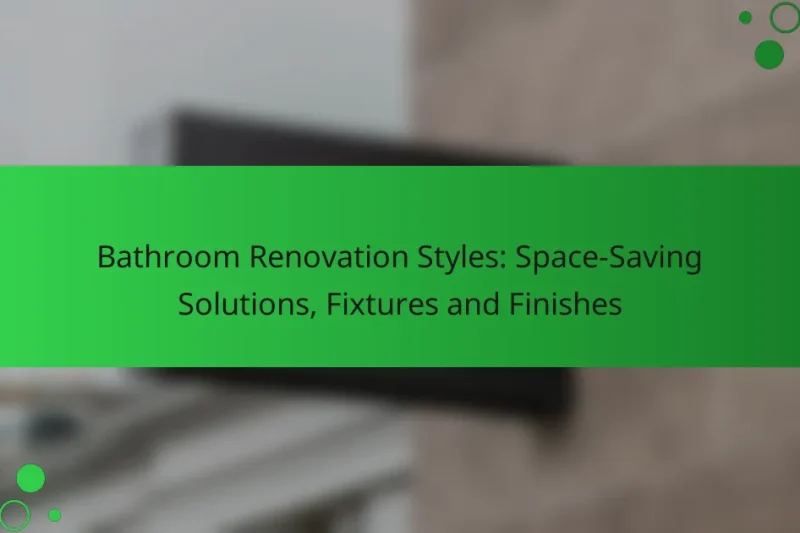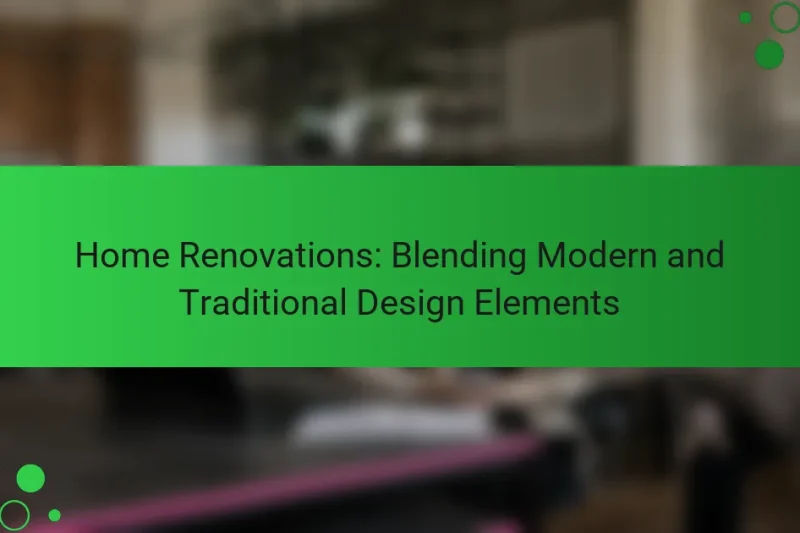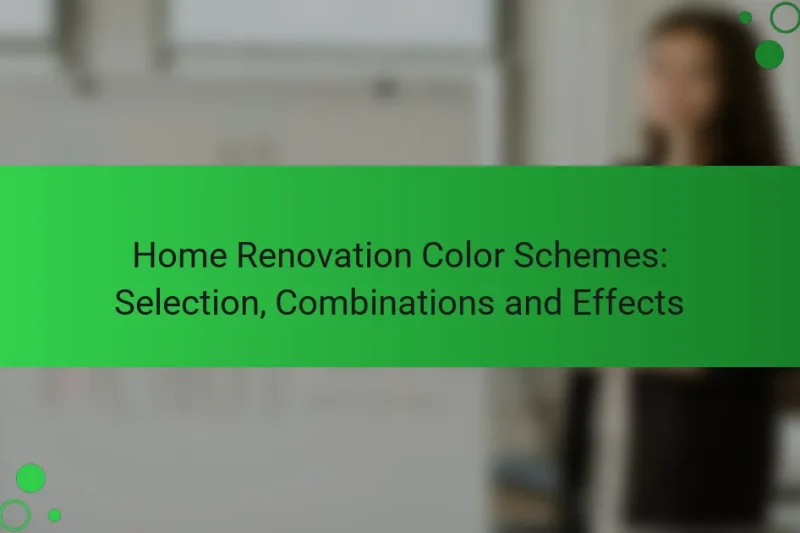Bathroom renovations can transform small spaces into functional and stylish retreats by focusing on space-saving solutions. … Bathroom Renovation Styles: Space-Saving Solutions, Fixtures and FinishesRead more
Home Renovation Design Trends
In 2023, home renovation design trends focus on open spaces, sustainability, and the seamless integration of technology. Homeowners are prioritizing designs that not only enhance functionality but also showcase their personal style and commitment to environmental consciousness. By carefully selecting a design style that aligns with individual tastes and existing architectural elements, you can create a cohesive space that meets your lifestyle needs.
Kitchen Renovation Trends: Modern Styles, Color Palettes and Layouts
Kitchen renovation trends are evolving to prioritize open-concept designs, smart technology, and eco-friendly materials, all while … Kitchen Renovation Trends: Modern Styles, Color Palettes and LayoutsRead more
Open Concept Living Spaces: Design Ideas, Benefits and Layouts
Open concept living spaces are designed to create a harmonious flow between different areas, fostering a … Open Concept Living Spaces: Design Ideas, Benefits and LayoutsRead more
Sustainable Design Trends: Eco-Friendly Materials, Energy Efficiency and Aesthetic Appeal
As sustainable design trends gain momentum in urban environments, the focus is on integrating eco-friendly materials, … Sustainable Design Trends: Eco-Friendly Materials, Energy Efficiency and Aesthetic AppealRead more
Home Renovations: Blending Modern and Traditional Design Elements
Blending modern and traditional design in home renovations creates a unique aesthetic that enhances both character … Home Renovations: Blending Modern and Traditional Design ElementsRead more
Home Renovation Color Schemes: Selection, Combinations and Effects
Choosing the right color scheme for home renovation is essential for creating a harmonious and inviting … Home Renovation Color Schemes: Selection, Combinations and EffectsRead more
Smart Home Technology: Integration, Benefits and Design Considerations
Smart home technology is revolutionizing the way we live by providing enhanced energy efficiency, improved security, … Smart Home Technology: Integration, Benefits and Design ConsiderationsRead more
What are the latest home renovation design trends in 2023?
The latest home renovation design trends in 2023 emphasize open spaces, sustainability, and technology integration. Homeowners are increasingly looking for designs that enhance functionality while reflecting personal style and environmental consciousness.
Open floor plans
Open floor plans continue to dominate home renovations in 2023, creating seamless transitions between living spaces. This design approach fosters a sense of community and maximizes natural light, making homes feel larger and more inviting.
When considering an open floor plan, think about how to maintain distinct areas for cooking, dining, and relaxation without walls. Use furniture arrangements and area rugs to define spaces, ensuring each zone serves its purpose effectively.
Sustainable materials
Sustainable materials are a key focus in home renovations this year, reflecting a growing awareness of environmental impact. Homeowners are opting for reclaimed wood, bamboo, and recycled materials that reduce waste and carbon footprint.
When selecting sustainable options, look for certifications like FSC (Forest Stewardship Council) for wood products or LEED (Leadership in Energy and Environmental Design) for overall building practices. These choices not only benefit the planet but can also enhance the aesthetic appeal of your home.
Smart home technology
Smart home technology is increasingly integrated into renovations, offering convenience and energy efficiency. Features such as smart thermostats, lighting systems, and security cameras can be controlled remotely, enhancing both comfort and safety.
Consider starting with a central hub that connects various devices, allowing for easy management. Prioritize systems that are user-friendly and compatible with existing devices to ensure a smooth transition into smart living.
Biophilic design
Biophilic design focuses on incorporating natural elements into home interiors, promoting well-being and connection to nature. This trend includes features like indoor plants, natural light, and water elements, which can create a calming atmosphere.
To implement biophilic design, use large windows to maximize daylight and select houseplants that thrive indoors. Consider water features, such as small fountains, to enhance tranquility and improve air quality.
Bold colors and patterns
Bold colors and patterns are making a comeback in home renovation, allowing homeowners to express their individuality. Vibrant hues and striking designs can transform spaces, creating focal points and energizing environments.
When using bold colors, start with an accent wall or statement furniture piece to avoid overwhelming the space. Pair bold patterns with neutral tones to balance the overall look and create a cohesive design.
How to choose a home renovation design style?
Choosing a home renovation design style involves identifying your personal tastes, considering the existing architectural elements, and ensuring the space meets your functional needs. A thoughtful approach will help create a cohesive and appealing environment that reflects your lifestyle.
Assess personal preferences
Start by exploring various design styles such as modern, traditional, industrial, or farmhouse. Collect inspiration from magazines, websites, and social media platforms to identify what resonates with you. Create a mood board to visualize your preferences and narrow down your choices.
Consider how each style aligns with your personality and daily life. For instance, if you enjoy minimalism, a modern design with clean lines and neutral colors may suit you best. On the other hand, if you prefer warmth and character, a rustic or eclectic style might be more appealing.
Consider architectural style
Your home’s architectural style plays a crucial role in determining the renovation design. Analyze the existing features, such as rooflines, window styles, and materials, to ensure your renovation complements the overall structure. For example, a Victorian home may benefit from classic design elements, while a contemporary house might embrace sleek, modern finishes.
Maintaining architectural integrity can enhance your home’s value and appeal. Research local regulations or guidelines that may dictate how renovations should align with the neighborhood’s character, especially in historic districts.
Evaluate functionality needs
Assess how you use your space and what improvements can enhance daily living. Identify areas that require better flow, storage solutions, or updated amenities. For example, if you frequently entertain, consider an open floor plan that promotes social interaction.
Prioritize your renovation goals based on your lifestyle. If you have a growing family, focus on creating functional spaces like a larger kitchen or additional bedrooms. Make a checklist of must-haves versus nice-to-haves to guide your design decisions effectively.
What are the costs associated with home renovation design?
Home renovation design costs can vary significantly based on several factors, including the scope of the project, materials used, and labor expenses. Understanding these costs is essential for budgeting and planning your renovation effectively.
Average cost per square foot
The average cost per square foot for home renovations typically ranges from $100 to $300, depending on the complexity and quality of the work. For instance, basic updates like painting or flooring may fall on the lower end, while extensive remodels involving structural changes can reach the higher end of the spectrum.
In urban areas, such as New York or San Francisco, costs can exceed $500 per square foot due to higher labor rates and material costs. Always consider local market conditions when estimating expenses.
Cost breakdown by room
Renovation costs can vary significantly by room. For example, kitchen remodels often range from $15,000 to $50,000, depending on the extent of the upgrades and appliances chosen. Bathrooms typically cost between $5,000 and $25,000, influenced by fixtures and finishes.
Living areas and bedrooms may require less investment, generally ranging from $1,000 to $10,000 for cosmetic updates. A detailed breakdown can help prioritize spending based on your renovation goals.
Factors affecting renovation costs
Several factors can influence renovation costs, including the choice of materials, labor rates, and project complexity. High-quality materials and custom designs tend to increase expenses, while standard options can help keep costs down.
Additionally, the location of your home plays a crucial role; renovations in metropolitan areas often incur higher labor costs. It’s also vital to account for potential unforeseen issues, such as structural repairs or code compliance, which can add to the overall budget.
How to find a reliable home renovation designer in Los Angeles?
To find a reliable home renovation designer in Los Angeles, start by researching professionals with strong reputations and proven track records. Focus on their experience, client feedback, and the quality of their past projects to ensure they align with your vision and needs.
Check online reviews
Online reviews are a valuable resource for assessing the reliability of home renovation designers. Look for platforms like Yelp, Google, and Houzz where clients share their experiences. Pay attention to both the number of reviews and the overall ratings, as a high volume of positive feedback often indicates a trustworthy designer.
Be cautious of designers with only a few reviews or those with a mix of good and bad ratings. A consistent pattern of satisfaction among clients is a better indicator of quality service.
Ask for referrals
Referrals from friends, family, or colleagues can lead you to reliable home renovation designers. Personal recommendations often provide insights into the designer’s work ethic, communication style, and ability to meet deadlines.
When asking for referrals, inquire about specific projects and the overall satisfaction with the renovation process. This firsthand information can help you make a more informed decision.
Review portfolios
Reviewing portfolios is essential to gauge a designer’s style and capabilities. Look for a diverse range of completed projects that showcase their versatility and creativity. A well-organized portfolio should include high-quality images and descriptions of each project.
Consider how the designer’s previous work aligns with your vision. If you prefer modern aesthetics, ensure their portfolio includes similar styles. Additionally, check for any awards or recognitions that may highlight their expertise in the field.
What are the benefits of eco-friendly home renovations?
Eco-friendly home renovations offer numerous advantages, including reduced energy costs and a smaller environmental footprint. By utilizing sustainable materials and energy-efficient systems, homeowners can create healthier living spaces while contributing to environmental conservation.
Energy efficiency
Energy efficiency is a key benefit of eco-friendly renovations, as it leads to lower utility bills and improved comfort. Upgrading insulation, installing energy-efficient windows, and using Energy Star-rated appliances can significantly reduce energy consumption.
Consider implementing smart home technology to optimize energy use. Smart thermostats and lighting systems can adjust automatically based on occupancy, further enhancing energy savings. Homeowners can typically expect a reduction in energy costs by 20-30% after making these upgrades.
When planning for energy-efficient renovations, prioritize areas that consume the most energy, such as heating, cooling, and water heating. Conducting an energy audit can help identify specific improvements that will yield the best return on investment. Avoid common pitfalls, such as neglecting proper sealing and insulation, which can undermine energy efficiency efforts.






